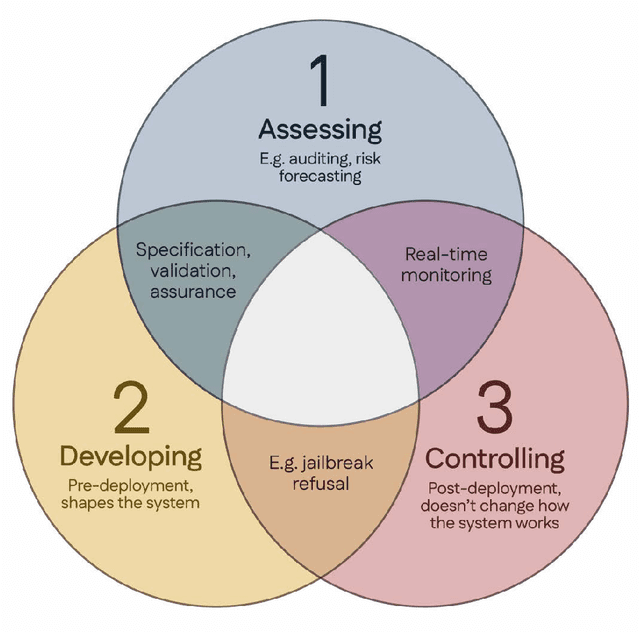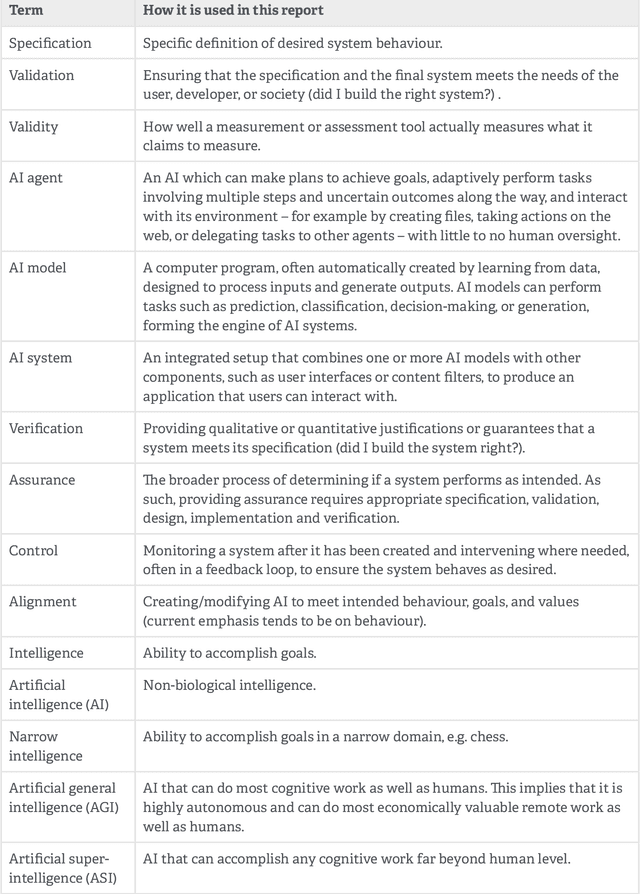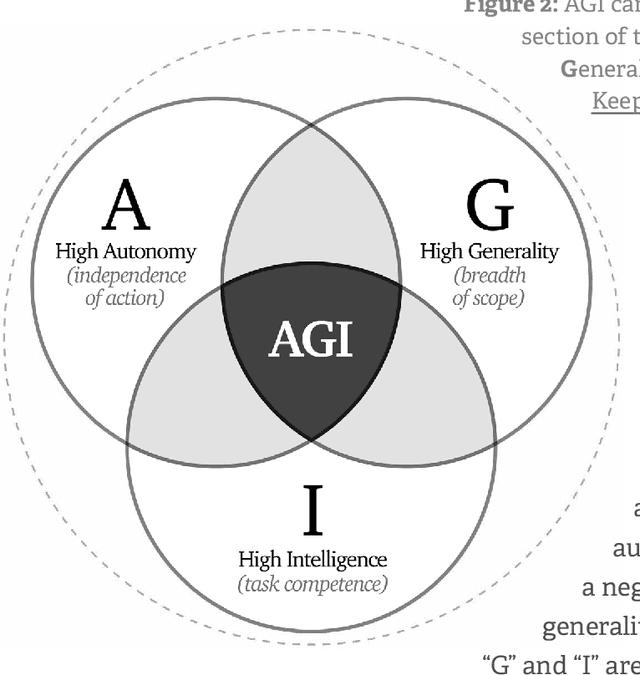Aradhana Sinha
The Singapore Consensus on Global AI Safety Research Priorities
Jun 25, 2025


Abstract:Rapidly improving AI capabilities and autonomy hold significant promise of transformation, but are also driving vigorous debate on how to ensure that AI is safe, i.e., trustworthy, reliable, and secure. Building a trusted ecosystem is therefore essential -- it helps people embrace AI with confidence and gives maximal space for innovation while avoiding backlash. The "2025 Singapore Conference on AI (SCAI): International Scientific Exchange on AI Safety" aimed to support research in this space by bringing together AI scientists across geographies to identify and synthesise research priorities in AI safety. This resulting report builds on the International AI Safety Report chaired by Yoshua Bengio and backed by 33 governments. By adopting a defence-in-depth model, this report organises AI safety research domains into three types: challenges with creating trustworthy AI systems (Development), challenges with evaluating their risks (Assessment), and challenges with monitoring and intervening after deployment (Control).
InfAlign: Inference-aware language model alignment
Dec 27, 2024Abstract:Language model alignment has become a critical step in training modern generative language models. The goal of alignment is to finetune a reference model such that the win rate of a sample from the aligned model over a sample from the reference model is high, subject to a KL divergence constraint. Today, we are increasingly using inference-time algorithms (e.g., Best-of-N, controlled decoding, tree search) to decode from language models rather than standard sampling. However, the alignment objective does not capture such inference-time decoding procedures. We show that the existing alignment framework is sub-optimal in view of such inference-time methods. We then modify the alignment objective and propose a framework for inference-aware alignment (IAPO). We prove that for any inference-time decoding algorithm, the optimal solution that optimizes the inference-time win rate of the aligned policy against the reference policy is the solution to the typical RLHF problem with a transformation of the reward. This motivates us to provide the KL-regularized calibrate-and-transform RL (CTRL) algorithm to solve this problem, which involves a reward calibration step and a KL-regularized reward maximization step with a transformation of the calibrated reward. We particularize our study to two important inference-time strategies: best-of-N sampling and best-of-N jailbreaking, where N responses are sampled from the model and the one with the highest or lowest reward is selected. We propose specific transformations for these strategies and demonstrate that our framework offers significant improvements over existing state-of-the-art methods for language model alignment. Empirically, we outperform baselines that are designed without taking inference-time decoding into consideration by 8-12% and 4-9% on inference-time win rates over the Anthropic helpfulness and harmlessness dialog benchmark datasets.
Automated Adversarial Discovery for Safety Classifiers
Jun 24, 2024Abstract:Safety classifiers are critical in mitigating toxicity on online forums such as social media and in chatbots. Still, they continue to be vulnerable to emergent, and often innumerable, adversarial attacks. Traditional automated adversarial data generation methods, however, tend to produce attacks that are not diverse, but variations of previously observed harm types. We formalize the task of automated adversarial discovery for safety classifiers - to find new attacks along previously unseen harm dimensions that expose new weaknesses in the classifier. We measure progress on this task along two key axes (1) adversarial success: does the attack fool the classifier? and (2) dimensional diversity: does the attack represent a previously unseen harm type? Our evaluation of existing attack generation methods on the CivilComments toxicity task reveals their limitations: Word perturbation attacks fail to fool classifiers, while prompt-based LLM attacks have more adversarial success, but lack dimensional diversity. Even our best-performing prompt-based method finds new successful attacks on unseen harm dimensions of attacks only 5\% of the time. Automatically finding new harmful dimensions of attack is crucial and there is substantial headroom for future research on our new task.
Generalized People Diversity: Learning a Human Perception-Aligned Diversity Representation for People Images
Jan 25, 2024



Abstract:Capturing the diversity of people in images is challenging: recent literature tends to focus on diversifying one or two attributes, requiring expensive attribute labels or building classifiers. We introduce a diverse people image ranking method which more flexibly aligns with human notions of people diversity in a less prescriptive, label-free manner. The Perception-Aligned Text-derived Human representation Space (PATHS) aims to capture all or many relevant features of people-related diversity, and, when used as the representation space in the standard Maximal Marginal Relevance (MMR) ranking algorithm, is better able to surface a range of types of people-related diversity (e.g. disability, cultural attire). PATHS is created in two stages. First, a text-guided approach is used to extract a person-diversity representation from a pre-trained image-text model. Then this representation is fine-tuned on perception judgments from human annotators so that it captures the aspects of people-related similarity that humans find most salient. Empirical results show that the PATHS method achieves diversity better than baseline methods, according to side-by-side ratings from human annotators.
Break it, Imitate it, Fix it: Robustness by Generating Human-Like Attacks
Oct 25, 2023



Abstract:Real-world natural language processing systems need to be robust to human adversaries. Collecting examples of human adversaries for training is an effective but expensive solution. On the other hand, training on synthetic attacks with small perturbations - such as word-substitution - does not actually improve robustness to human adversaries. In this paper, we propose an adversarial training framework that uses limited human adversarial examples to generate more useful adversarial examples at scale. We demonstrate the advantages of this system on the ANLI and hate speech detection benchmark datasets - both collected via an iterative, adversarial human-and-model-in-the-loop procedure. Compared to training only on observed human attacks, also training on our synthetic adversarial examples improves model robustness to future rounds. In ANLI, we see accuracy gains on the current set of attacks (44.1%$\,\to\,$50.1%) and on two future unseen rounds of human generated attacks (32.5%$\,\to\,$43.4%, and 29.4%$\,\to\,$40.2%). In hate speech detection, we see AUC gains on current attacks (0.76 $\to$ 0.84) and a future round (0.77 $\to$ 0.79). Attacks from methods that do not learn the distribution of existing human adversaries, meanwhile, degrade robustness.
Improving Few-shot Generalization of Safety Classifiers via Data Augmented Parameter-Efficient Fine-Tuning
Oct 25, 2023

Abstract:As large language models (LLMs) are widely adopted, new safety issues and policies emerge, to which existing safety classifiers do not generalize well. If we have only observed a few examples of violations of a new safety rule, how can we build a classifier to detect violations? In this paper, we study the novel setting of domain-generalized few-shot learning for LLM-based text safety classifiers. Unlike prior few-shot work, these new safety issues can be hard to uncover and we do not get to choose the few examples. We demonstrate that existing few-shot techniques do not perform well in this setting, and rather we propose to do parameter-efficient fine-tuning (PEFT) combined with augmenting training data based on similar examples in prior existing rules. We empirically show that our approach of similarity-based data-augmentation + prompt-tuning (DAPT) consistently outperforms baselines that either do not rely on data augmentation or on PEFT by 7-17% F1 score in the Social Chemistry moral judgement and 9-13% AUC in the Toxicity detection tasks, even when the new rule is loosely correlated with existing ones.
 Add to Chrome
Add to Chrome Add to Firefox
Add to Firefox Add to Edge
Add to Edge